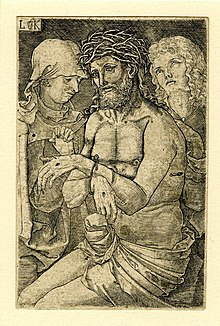created 2025-04-09, & modified, =this.modified
Ostentatio genitalium (Latin for “display of the genitals”) refers to artistic emphasis of the genitals of Christ in Renaissance paintings.

It can take the form of exposed display, demonstrative hand positions, (self) touch, exaggerated textile draping, etc. The term adapted the existing feature in iconography of the ostentatio vulnerum or “display of wounds”, where Christ indicates the wound in his side.
There are many theories about the origin of ostentatio genitalium. One of them connects it with the rise of Franciscan spirituality in the 13th century, and its slogan nudus nudum Christum sequi (“naked to follow the naked Christ”). Another sees it as part of the Renaissance movement towards anatomical correctness and naturalism in art.
Beginning around 1260 and enjoying widespread employment before finally tapering off in the seventeenth-century, ostentatio genitalium reversed a Byzantine tendency to depict Christ as sexless, his missing organs covered by flat, diaphanous veils